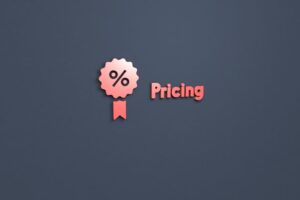What is Market-Based Pricing?
Market-based pricing is a pricing strategy that determines the price of a product based on what customers are prepared to pay. Instead of using production costs or a profit margin, businesses can set prices by considering how much customers want the product, how much their competitors are charging, and the perceived value of their product.
Understanding how individuals perceive the worth of your product is essential for market-based pricing, as customer expectations and competitors have an impact on the pricing strategy.
Market-Based Pricing for Software Companies
Setting the correct pricing for your product can be tasking; let’s consider Loom and Microsoft Teams.
While both tools help streamline team communication, Loom’s fee was first justified by its unique features and user experience. Microsoft, on the other hand, combined Teams with its Office 365 suite to compete, thus shifting its market-based price.
Adobe‘s shift from selling Photoshop as a single product to including it in a monthly subscription-based Creative Cloud service is a classic example of responding to the feeling of the market.
Adobe modified its pricing approach in response to the industry’s trend toward subscription models and its customers’ willingness to pay for regular updates and cloud services.
However, market-based pricing strategy is not without its own challenges. Misunderstanding or undervaluing your product could result in a loss of potential income and customers.
For you to find the sweet spot with market-based pricing, you must continually research, create feedback loops, and stay updated on industry trends.
MORE: What is bundle pricing?

Components of Market-Based Pricing
Customer Demand
Market-based price is based on what the customer wants. When you understand the demand for your product, you can figure out how businesses and individuals require it and how much they are willing to pay for it.
It’s not just about having a great product; you must also know why people want your product. Customer demand helps companies maintain a relevant and profitable position.
MORE: What is penetration pricing?
Competitive Analysis
There are likely ten or more competitors offering a similar product to yours in the saturated market, this is where competitive analysis comes in. Competitive analysis entails understanding how your software compares to that of competitors.
By examining competitors’ features, benefits, and pricing, you can establish a price range that reflects your software’s unique value while ensuring you aren’t underpricing or overcharging.
MORE: How to use competitive pricing?
Elasticity of Demand
The elasticity of demand tells you how the demand for your product or service changes when the price changes. If a small price increase causes a big drop in demand, your product is deemed “elastic.” On the other hand, demand is “inelastic” if it stays the same no matter what the price is.
It is important to understand this flexibility. It helps you decide whether to offer premium plans, deals, or keep prices the same so that the dance between price and demand stays smooth.
MORE: What is captive product pricing?
External Factors
Shifts in the economy and regulatory changes are some of the external factors that can also influence market-based pricing.
In the event of a recession, companies may become more cost-conscious, compelling businesses to adjust their prices. Your pricing strategy will remain robust and effective if you are flexible and can respond swiftly to these factors.
MORE: What is odd even pricing?
How to Calculate Market-Based Pricing
To calculate market-based pricing, you need to consider two main factors; the cost of your product and the market price.
The cost of the product is the amount it costs to produce, while the market price is the average price of similar products in the market.
Once you’ve determined these two values, you can use the following formula to calculate your market-based price:
Market-based price = Cost of product + Market price + Premium
Premium is any additional amount that you want to charge for your product, based on its unique features, benefits, or your brand value.
You can also determine your market-based price by researching your competitors’ product prices. Once you know how prices are moving, you can use the average as your own price point.
Advantages of Market-Based Pricing
Aligning with Customer Expectations and Willingness to Pay
Understanding what customers are willing to pay is the foundation of market-based pricing.
You can set more accurate rates by evaluating customers’ willingness to pay.
Flexibility to Market Changes
The software industry is noted for its dynamism, with new solutions and rivals emerging daily.
Market-based pricing can help you alter your prices in reaction to market shifts, enabling you to remain competitive and relevant.
Potential for Higher Profits
Companies have the potential to realize higher profits, particularly if their solution offers unique value.
You can command premium prices by strategically positioning your product and capitalizing on market demand.
MORE: What is enterprise pricing?
Disadvantages of Market-Based Pricing
Misinterpretation of the Market
Using market-based pricing requires precise data and a thorough understanding of your industry. Misinterpreting these can result in pricing that is either too high or too low for your product.
This error can be especially damaging to startups yet to establish a market presence.
Failure to Account for All Costs
Focusing solely on what the market is ready to pay might cause you to lose sight of your cost structure.
If the market-based price does not cover costs associated with software businesses, such as client acquisition and maintenance, revenue generation may become difficult.
Becoming a Price Follower Rather Than a Leader
When businesses base their prices on market trends and expectations, they put themselves at the risk of being reactive, continuously adapting to competition.
This could cause a company to lose its unique value offer and become a market follower instead of an authority in the market.
MORE: What is usage-based pricing?
Is Market-Based Pricing Strategy Ideal for My Business?
If practiced right, market-based pricing can be a game changer for your business. For example, Trello used market data to tier their price, appealing to a wide range of consumers from solo planners to vast corporate teams.
This strategy helped them to remain competitive while maximizing revenue from various segments.
While market-based pricing allows for greater flexibility and compliance with consumer expectations, it also needs continual examination. You must conduct frequent competitive research, get feedback from your customers, and stay updated on trends in the industry.
The success of a market-based pricing strategy is usually driven by the nature of your business, the uniqueness of your product, and your perception of your target audience.
It is important to thoroughly analyze the market to assess whether the perceived value of your product or service can sustain the price you want to charge.
MORE: What is prestige pricing?
Best Practices for Implementing Market-Based Pricing
Continuous Market Research
Start by segmenting your target audience and learning about each segment’s unique demands and issues.
Conduct surveys and user interviews, and use analytics tools to determine how and why consumers interact with your product. The insights you gain can help you determine if your current price is in line with the perceived value of your service.
Customer feedback, particularly from long-term users, can also give useful information about your software’s perceived value and acceptable pricing points. Constant feedback guarantees that your pricing strategy responds to shifting market conditions and customer needs.
Regularly Review and Adjust Pricing
Consider doing quarterly, biannually, or yearly evaluations to analyze the efficacy of your present price.
Analyze factors such as customer acquisition cost and lifetime value during these assessments to see if your price is ideal.
While pricing adjustments are occasionally required, frequent and significant fluctuations could deter customers. Any changes should be made with care, with clear communication to current consumers on the reasons for and advantages of the change.
Staying Updated
Set up ways to keep track of industry news, new developments, and new products from competitors. By examining how your competitors price their products, you can learn about the direction of the market and find gaps in your own pricing plan.
However, while it’s important to know what they’re doing, keeping your own value offering is equally important.
Don’t just copy what your competitors are doing; try to offer more value through better features, better customer service, or something else that makes your product stand out.
MORE: What is psychological pricing?
Key Takeaways
Market-based pricing focuses on understanding customer demand, competitive positioning, and the perceived value of a product or service, which is even more important for businesses in the software industry.
Implementing this strategy requires continuous market research, regular price adjustments in reaction to market behavior, and a deep understanding of industry trends and competitors’ operations.
While it promises to meet consumer expectations and enhance revenue, actual success requires paying close attention and being flexible to market shifts.
For more pricing information to help guide your business, visit our SaaS Pricing pages.
Related Posts
Frequently Asked Questions (FAQ)
Author
Methodology
- Who?
We are SaaS experts: Our specialists constantly seek the most relevant information to help support your SaaS business. - Why?
We are passionate about users accessing fair SaaS pricing: We offer up-to-date pricing data, reviews, new tools, blogs and research to help you make informed SaaS pricing decisions. - How?
With accurate information: Our website manager tests each software to add a Genius Score using our rating methodology to each product. Our editorial team fact-check every piece of content we publish, and we use first-hand testing, value metrics and leading market data.










